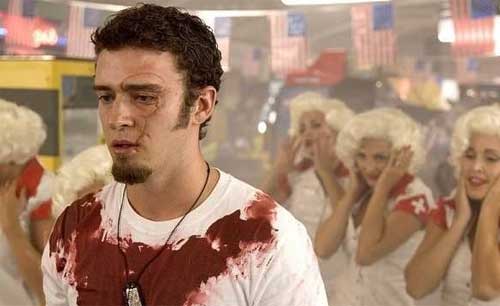Title: Bullet To The Head
Director: Walter Hill
Released: 2012
Starring: Sylvester Stallone, Sung
Kang, Sarah Shahi, Adewale Akinnuoye-Abaje, Christian Slater, Jason Momoa
Plot: Hitman James Bonomo
(Stallone) and police detective Taylor Kwon (Kang) find themselves forced to
work together when they find themselves targeted by the same enemy.
Review: Not to be confused by the superior John Woo classic "Bullet In The Head" and Based on Alexis Nolent’s French graphic novel “Du
Plomb Dans La Tete” loosely translated as “Lead In The Head” with this film would
come for Stallone at a time when he was riding high once more in his career,
having dragged himself out of the depths of DTV hell by revisiting the roles
which first made him a star, as well as cashing in on that legacy further with
the first two entries in “The Expendables” trilogy. Of course we would be heavily
mistaken if we thought that Stallone was back on track as here he sleepwalks
his walks through this shambling Neo-Noir thriller.
Now the idea of someone with a legacy like Walter
Hill has in the director’s chair it would normally be something to be excited about, but sadly
this is not working at his prime as we like to remember him with films like
“The Warriors” or “Southern Comfort”. With this film though it is hard to tell
if these lacklustre effort is to do with a veteran director losing his mojo or
the fact that he was drafted in to replace Wayne Kramer who wanted a darker
vision for the film than Stallone wanted, leading to Stallone bringing in Hill
who at the time had at the time just had the movie he’d been working on fall
apart after he’d spent a year trying to get it made.
Refreshing set in New Orleans, here Stallone’s Bonomo also
known as the bafflingly unthreatening Jimmy Bobo, is an aging hitman who lives
by his own code of conduct, as emphasised by the opening hit on a corrupt cop
in which he refuses to kill a prostitute witness. It is of course this hit
which Bobo on the radar of Kwon who was the cops partner and from here it is
only an onslaught of confused plotlines with only the occasional dash of action
to keep the mildest hint of interest in this otherwise bland thriller. Things head south pretty quickly here after a strong
opening, with the Bobo and Kwon being forced to work together, but thanks to
Stallone and Kang having zero chemistry together this is far from the mismatched
partner dynamic we would expect with every situation usually consisting on
Stallone handling the action, while Kang plays on his phone. Seriously there is
no situation which doesn’t seemingly find a resolution by him looking up the
answer on his phone making his credentials as a detective all the more shaky
while making you wonder why his character had to be a cop and instead couldn’t
have been a hacker or some other profession. Interestingly though Thomas Jane
was to play this role, only for producer Joel Silver to recast the part feeling
needed a “more ethnic actor” to appeal to a wider audience. It remains to be
seen if Jane could have done a better job, or if the flaw is just in the
character. Elsewhere Shahi shows up as Bobo’s tattooist daughter who supposedly
according to Bobo’s claims went to med school for a week, yet has no problem
dealing with gun shot wounds or any other medical issue that arises. Frustratingly
while Shahi gives a good performance, her character seems to largely have been
included as an excuse to up the nudity quota or just so Hill could have a
pretty girl in the cast, especially when her character could have easily have
been written out without any effect to the film in the slightest.
The other main issue with the film is the lack of a decent
big evil with the closest we get to a memorable villain is in ex-mercenary
turned heavy Keegan (Momoa) who gets one of the few highlights of the film when
he gets to engage in a fire axe dual with Bobo at the finale. While the
character is memorable, its another lacklustre performance from Momoa, who the
more I see the more convinced I am that his performance as Khal Drogo in “Game
of Thrones” was a one off, especially when everything else I’ve seen him in has
yet to come close to that performance as further reinforced here.
The action scenes are all enjoyable enough, though hardly
containing anything overly original to make them standout more, while the final
axe dual despite containing a number of impressive moments, relies too heavily
on close up shots to be truly effective. We also get a massage parlour brawl
but again I struggled to get into this fight, mainly because it felt like a
poor man’s version of the same scene in “Eastern Promises” only thankfully
Stallone doesn’t get naked in this one.
A forgettable Neo-Noir thriller let alone a heavily flawed
one which even the diehard Stallone fans will struggle to find anything to make
it worth your time. At the same time it remains to be seen if Hill can
recapture his film making mojo which made his early films so memorable
especially when this is certainly a stumble on his resume. Of course this is
only made all the more frustrating when here is clearly trying to do something new
within the genre, especially in terms of setting, its just a shame that the few
moments when the film does work, don’t make up for the rest of the film to
warrant giving it anything but a curious watch.


























